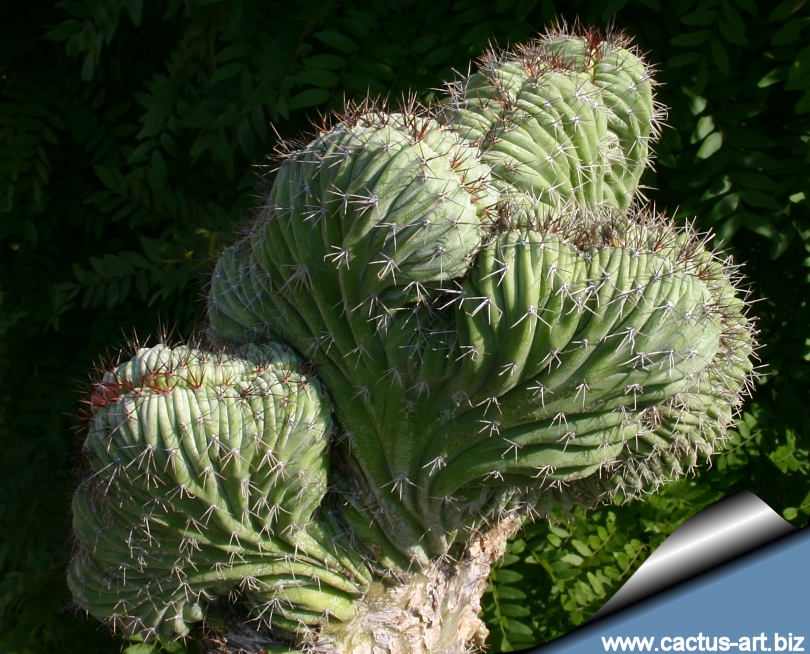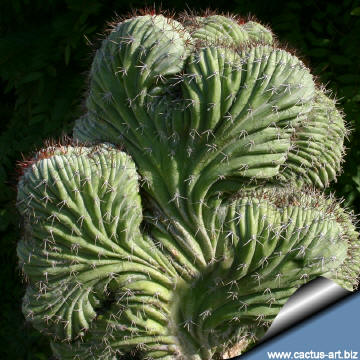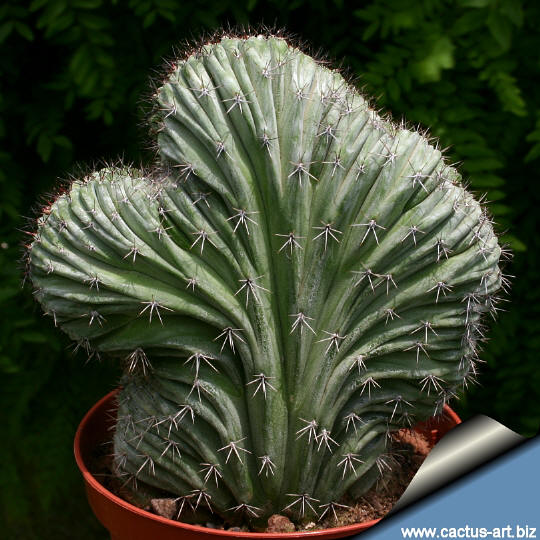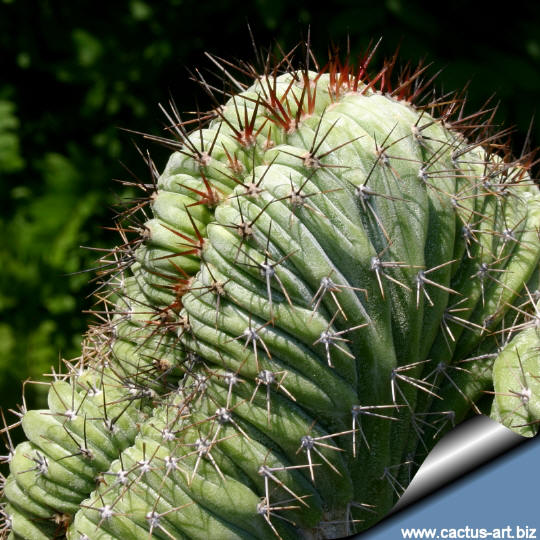|
|
|

Polaskia chichipe forma cristata
This is a very attractive crest with powdery grey stems.
|
Description:
The
standard Polaskia chichipe is a columnar tree-like cactus with many
curved branches, up to 5 m tall.
The beautiful crested form is very rare in collection and highly priced
for its sculptural shape and powdery grey-blue epidermis. Older crested
plant can reach a considerable size (up to 2 m tall and in diameter, or
more )
Stems: Powdery grey and green with wavy ribs;
Areoles: 1 to 1.5 cm apart;
Spines: Greyish up to 5cm but usually shorter; 1 central spine;
6-8 radials.
Flowers: Small yellowish-green. Anthesis diurnal as well as
partly nocturnal.
Fruit: 2-3 cm edible.
Economical uses: Polaskia chichipe is
cultivated in central Mexico for its edible red fruits (chichituna) and branches used as
fuel wood. Cultivated plants have larger and sweeter fruits, a longer
period of fruit production, and are self-compatible.
|
 |
|
|
This is undoubtedly one of the nicest crest
cacti.
|
|
Cultivation: Polaskia grow slowly and are
cold intolerant, make sure that they are not exposed to
freezing temperatures or they may die. During the summer it is best to
keep the plants outside where the temperature can rise to over 30 C with
no harm to the plant. Furnish good drainage and use a an open and free
draining mineral compost that allows therefore roots to breath. They
like only a short winter's rest and should be kept almost completely dry
during the winter months, If the soil is allowed to be dry for too long
root loss could follow but equally the same result would occur if the
plants are both wet and cold. From March onwards the plant will begin to
grow and watering should be increased gradually until late May when the
plant should be in full growth.
Water regularly during the summer so long as the plant pot is allowed to
drain and not sit in a tray of water. During hot weather you may need to
water the plants more frequently so long as the plant is actively
growing. From late September watering should be reduced to force the
plant to go in to a state of semi dormancy, by October you should be
back in to the winter watering regime.
Need full sun avoiding only the harshest summer sun, if kept too dark
they may become overly lush and greener and could be prone to rotting
due to over watering.
Feeding may not be necessary at all if the compost is fresh then, feed
in summer only if the plant hasn't been repotted recently. Do not feed
the plants from September onwards as this can cause lush growth which
can be fatal during the darker cold months.
Propagation: by
vegetative propagation grafting or stem cuttings. |
|


Advertising
|
|
|
|
Family:
Cactaceae (Cactus
Family)
Scientific name:
Polaskia chichipe
(Roland-Gosselin)
Backeberg 1949
Origin: From warmer areas of central Mexico (Puebla:
Tehuacan, reaches into the state of Oaxaca)
Habitat: This plant occurs in the wild in
thorn-scrub forests.
Common Name: Chichipe, Chichibe,
Chichituna
-
Cereus chichipe Rol.-Goss.
Place of publication: Bull. Mus. Hist. Nat. (Paris) 11(6):507.
(Basionym)
-
Lemaireocereus chichipe
(Roland-Gosselin) Britton et Rose 1920
-
Myrillocactus chichipe
(Roland-Gosselin) P. V. Heath 1992
-
Cereus mixtecensis
-
Lemaireocereus mixtecensis
Other possible synonyms for genus:
(= ) Chichipia Backeb., nom. inval.
(= ) Heliabravoa Backeb.
The genus Polaskia comprise 2 species: Polaskia
chichipe which is related to to Myrtillocactus and Polaskia chende which
is nearer to Stenocereus.
|
|
|
|


The
cause of cresting: The cause of cresting is not fully explained; biologists
disagree as to why some plant grow in this unusual form. Some
speculate that it is a genetic mutation. Others say it is the result of
lightning strike or freeze damage, but whatever the stimulus, the
growth point of the stem has switched from a geometric point, to a line,
which folds and undulates as the crest expands. Though these crested
Polaskia are somewhat rare, cresting occurs naturally, and can be encountered in many
other cactus species.
In the
ontogenesis
a crest can appear any time, but development of crests on large
columnar
cactus species ( such as the Polaskia) in the
early
stages
of ontogenesis is unlikely. On the other hand, small species may crest
early already at the
cotyledons
stage.
|
|